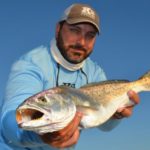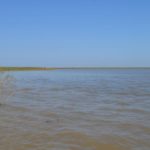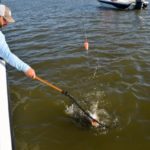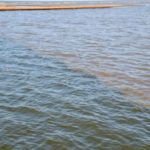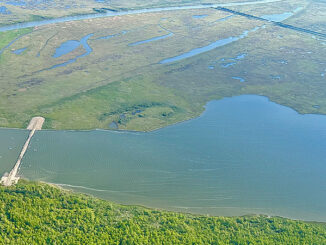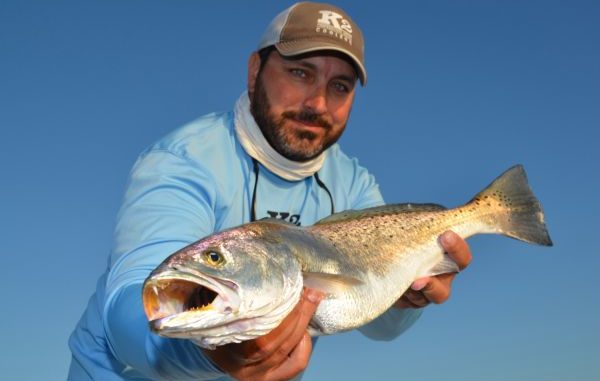
Yeah, the Mississippi River is high and roiling with mud during the spring thaw, but that doesn’t mean you can’t load up on speckled trout where it empties into the Gulf. Here’s how the pros do it.
Rule No. 1 for speckled trout fishing: Look for clean water.
As far as Louisiana speck fisherman go, that’s probably rule Nos. 2 and 3, as well. Their definition of “clean water” is clear water— that kind of green, fishy clear that makes their pulses run hard.
There is some dispute as to whether Mark Twain called the Missouri River or the Mississippi River “too thick to drink and too thin to plow.”
It doesn’t matter. The description fits both, especially during the spring run-off period.
The river rises in November or December, and with the rise comes an exponential increase in the mud and silt the river carries. It stays high and muddy until June.
So how do charter fishing guides who fish the mouth of the river — the muddy Mississippi River, the largest river on the North American continent — catch speckled trout year round?
To get an answer, I turned to Brandon Carter, owner of Reel Shot Guide Service (985-969-0810). I had worked with Carter before, featuring him in the book Trout Masters Too — How the Pros Do It.
The night before the trip, Carter said he believed one of the keys to success is that fish have adjusted to the riverine environment.
“I really believe that a lot of it is that our fish are used to muddy water,” he explained. “And, there are very few conditions under which we can’t find some clean water. No matter how high the river is, we can find pockets.”
It wasn’t until we went fishing the next day that I realized that the term “clean water” was relative and what Carter called clean water might not be considered clean by other trout fishermen.
Venice fishermen, he explained, watch the Mississippi River gauge in New Orleans to monitor the river’s condition.
“You can expect muddy water when the gauge is over 5 feet, but you can still find clean water outside (on the edge of the delta),” Carter said. “By 8 to 10 feet, it looks like you could plant corn in it — extremely dirty.
“Still during the record highs of 18 ½ feet at New Orleans, we were still catching trout.”
Why?
“The proximity to deeper water has a lot to do with that. A mile off the delta, it is 100 to 150 feet deep,” Carter said. “Off the Atchafalaya (River), you would have to run 20 miles offshore to find trout water.
“With the deep water nearby, the tide has more access to move saltier, clearer water inside.”
Finding that cleaner water isn’t as simple as just looking at the surface, he said.
“A rising tide can really make the water look ugly, but it is introducing salty water beneath the layer of muddy water,” Carter explained. “You can often watch the wheel wash of your motor as it turns up green water from beneath.
“It’s amazing how forceful that wedge of saltwater is. The river can be in flood stage, but a crew boat going upriver will turn up green water two miles up the river.”
Early the next morning, Carter ran straight downriver from Venice into South Pass. At the very end of the pass, he took a right into what locals call Coast Guard Cut.
“There is a shallow shelf 2 feet deep here,” he said. “Then it drops off quickly to the channel in the cut.
“River water and seawater are like oil and vinegar — they separate. If you were in Delacroix and you get muddy water, you get muddy water. This close to the river, it hasn’t had time to mix.
“The water will layer — fresh on top and salty beneath — with the trout beneath, or it will be in a tide line with the two waters side by side. The fish tend to be on the cleaner side.”
After easing into the cut, Carter scanned the surface, and for no apparent reason other than he knew where the shallow shelf was, he stopped to fish.
In the near distance, a tide line was clearly visible. On the other side of it, the water looked like chocolate soup. At first it was difficult to tell if the tide line was moving toward us or away from us.
He shoved one of the hooks of a 4x treble hook under the horn of a lively shrimp set 2 feet below a traditional popping cork and lobbed the bait into the shallows closer to the sandbar.
I was surprised to see him using a spinning rod and reel. Without taking his eyes off the cork for even a second, he explained that he always uses spinning tackle for fishing with a cork because it casts a cork with less effort and doesn’t sling the bait off the hook.
For everything else, he uses casting tackle.
“I like anything with ‘Shimano’ on its side,” he said of his reel. “I’ve been through all the other brands of reels and they don’t hold up.”
His favorite rods right now are 7-foot, 2-inch Aqua Dream Signature Series fast/medium-light rods.
“They are light, but have enough backbone to control a big fish,” Carter said. “And they have a real soft tip. It has a real sharp pop to the tip.”
His spinning reels were all spooled with Power Pro Super Slick braided line. He said he had recently shifted from 8/30 (30-pound-test line with the same diameter as 8-pound mono) line to 6/20 line because of the extra distance he gets on his casts.
His eyes detected the cork stopping its drift and slowly easing under water. He arched his powerful body upward and sank the hook home with a sharp strike.
He flipped a solid 4-pound speckled trout into the boat the way most people do schoolies.
Carter repeated the cast, with almost the same result, except the fish was a 2 ½-pounder, the smallest he took from this spot.
The bite was methodically slow, but the average size was spectacular.
Ominously, the tide line was clearly moving our way — slowly, but steadily.
To complicate things, another bay boat pulled up and positioned itself in such a way that it prevented Carter staying ahead of the movement of the tide line.
A 5-plus-pounder he just landed attracted the attention of the other anglers.
If the other boat’s positioning upset him, he didn’t let it show: He kept fishing, concentrating his energies on the cork, as if willing the fish to bite his hook.
He set the hook hard, but it pulled out after Carter got a good feel.
“That was a really big fish,” he groaned.
The tide line was crowding closer when he cast again. He couldn’t edge to the east because the other boat had hemmed him in.
Slowly Carter’s cork moved off before disappearing.
“Oh, this is a good fish,” he declared, as his rod arched over deeply.
As the fish neared the boat, he grabbed a landing net, something big-trout specialists like Carter hate to do for any fish smaller than 5 pounds.
“That fish will go over 7 pounds,” he said, as if it were an every-trip occurrence.
He had time for one more cast before the muddy water on the other side of the tide line overwhelmed the spot. It produced a beautiful redfish most people would have been happy to keep.
Carter disdainfully released it.
The three anglers in the other boat could only look on in envy. They hadn’t had a bite, proving the old speckled trout maxim that says, “You gotta find your own fish.”
With nine really nice specks in the box, Carter cranked the boat’s motor and ran to the mouth of Northeast Pass in Blind Bay to fish cane stubble. The north bank of the pass (the Blind Bay side) once had a large, anvil-shaped cane bank where the pass opened.
This was gone, replaced by a sharp point of canes that petered out into open water. Carter planned to focus his effort on the stubble field of what used to be the large cane patch, if he could find fishable water.
The river was high and pumping muddy water out of the pass. At first or even second glance, it all looked hopeless.
But slowly trolling the area and focusing on the water revealed that the water on the bay side of the pass was slightly less muddy than the waters being directly hammered by discharge from the pass.
More importantly, the propeller of his trolling motor turned up greener water beneath the muddy layer.
Carter immediately went to work, throwing shrimp under a cork again, with good results. Even though some of the trout were respectable, they were distinctly smaller than those caught earlier.
We went from wall-hangers to plate candy, which didn’t seem to bother the trophy-trout specialist a bit.
“Hey, they got fillets on both sides, and they got spots,” Carter said, his normally stolid face breaking into a grin.
The fishing was fast; these were willing biters. After boating 10 of them, Carter paused.
“I’ve got enough to eat — no need to pound them,” he murmured unemotionally.
I had my answer.
